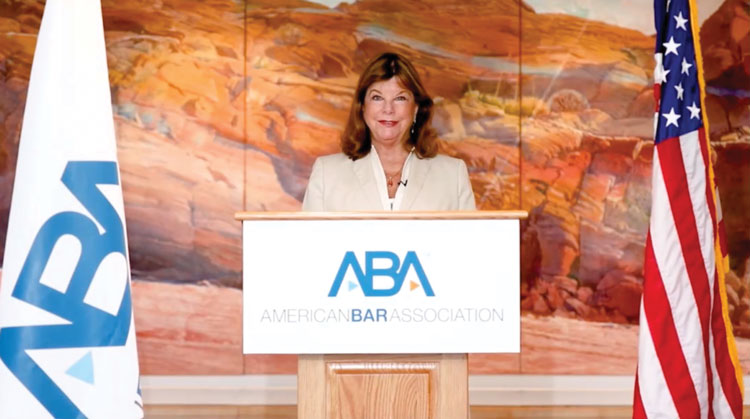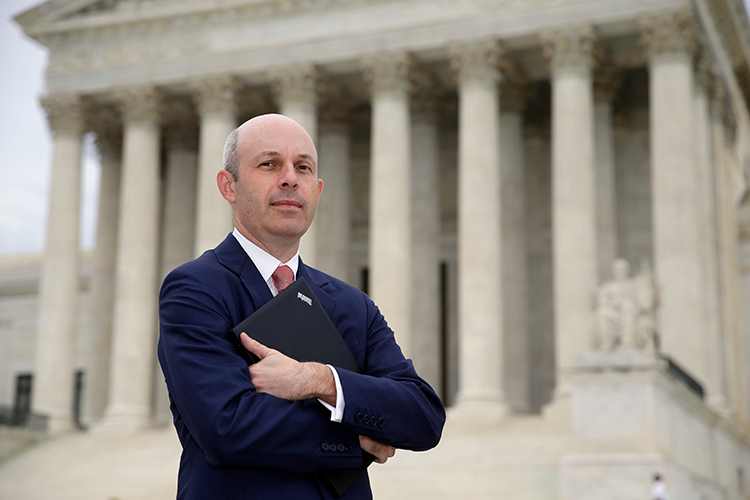Our 'profession is changing,' says ABA President Patricia Lee Refo

Photo of Patricia Lee Refo by Lee Rawles
Patricia Lee Refo became president of the ABA in August at the close of the first virtual annual meeting in the association’s history.
Refo is a partner at Snell & Wilmer in Phoenix and has served as chair of the House of Delegates and Section of Litigation. She also chaired the Standing Committee on Membership, the American Jury Project and ABA Day in Washington, D.C., and she was a member of the Commission on Civic Education and the Separation of Powers.
She spoke in September with the ABA Journal about plans for her term as president.
It’s been just about a month since you became the ABA’s president. What are your primary objectives as you get started?
We’re still smack in the middle of this pandemic, and so the primary focus right now is helping the profession and the justice system manage our way through this public health crisis. In addition, we are laser-focused on the other pandemic that our nation is experiencing, which is a health issue that is attacking our nation’s soul, that is around questions of racial equity and racial justice. We have a number of new initiatives designed to address racial equity in our criminal and civil justice system.
How do you hope to help the ABA combat these two pandemics?
One of the advantages the ABA has is the breadth and depth of our expertise and the helping hands we can put to work to solve a problem.
We are the largest voluntary association of lawyers in the world. When you put that organization to work, it can make important, meaningful change.
We have asked every single entity in the American Bar Association to move anti-racism and racial equity to the very top of their agenda for this year. And again, the scope and breadth of the work that is being done is, candidly, very difficult to summarize. It ranges from continuing legal education programming to webinars, to programming that is available to the general public, to policies and procedures around policing and police practices, to helping our court systems address racial equity and racial justice.
The legal profession itself looks a lot different than it did a year ago. What do you see as the most significant changes, and do you expect any to remain in place as we move into the new normal?
I expect a number of changes to the profession will stay with us. We have learned that lawyers can do their work without being physically together at a downtown high-rise office building. We have learned that lawyers and judges can effectively conduct much of the business of the court without being together in person. That’s one example where the long-term implications may be very positive for clients.
So if a lawyer and a client are in a remote part of the state, for example, and the appellate court is not easy to get to, a remote hearing saves a lot of time and energy and potentially money for the client. It becomes an access-to-justice issue as well by reducing legal costs.
At the same time, we have to continue our work to be sure that these changes do not disproportionately impact our underserved communities. We have to be certain that as we make changes to our justice system, they serve all of the public. For example, a remote hearing is only useful if you have the means to connect to that remote hearing. If you live in a place that doesn’t have broadband, that may be a serious problem.
The ABA has made increasing membership and revenue a priority in recent years. How do you plan to help the association address these issues, particularly now, given our country’s changes and challenges?
For lawyers and judges, the American Bar Association is more important and more relevant today than maybe it’s ever been, precisely because our world is changing and in flux. We just finished last year the most significant revamp of our membership model in a very long time, and the benefits that we offer now are even more significant and even more useful to lawyers in every possible practice setting. I personally intend to be an evangelist for ABA membership because I know the difference that it has made in my career.
I joined the American Bar Association as a young lawyer because the senior partner in my law firm told me that’s what you did if you were a lawyer. I never looked back. I started at the lowest rung of the ladder and kept saying yes to new assignments. Pretty soon, I was a committee chair and went on from there. It has over the course of my career not only made me a better lawyer, but it has introduced me to a network of people who I would never have had the chance to know and work with professionally. And I met my husband [Don Bivens] at an ABA meeting, so I really know how the ABA can change your life.
How did you know you wanted to be president of the ABA?
Being president of the ABA is the most extraordinary opportunity to serve the legal profession that I can imagine. It’s entirely a service job, but it’s an opportunity to help make change, particularly in this moment when so much about our future as a profession is changing. The good news, as I find myself grounded here in Phoenix, is that I did not pursue this job for all the travel opportunities. Ordinarily, the American Bar Association president is on the road literally hundreds of nights a year doing the business of the ABA. I, along with my predecessor Judy Perry Martinez, am learning how to do it from my dining room.
Looking back, what was most memorable from your year as president-elect?
We started the year in Harlingen, Texas, with the ABA team at ProBAR, who spend all their time, all their days working with persons who are detained on the U.S.-Mexico border. That was an eye-opening and extraordinary experience for me, to have the opportunity to work with persons being held in detention centers and to work side-by-side with the extraordinary lawyers at ProBAR.
I would say a second extraordinary experience for me as president-elect was the opportunity to visit with our colleagues in the organized bar in Australia. That was right before the pandemic. I literally got home from Australia on Sunday, and my law firm shut down on Friday in March. I was in Australia for about a week attending the Australian Bar Association annual meeting and meeting with bar leaders and law school deans … . It was a remarkable opportunity to learn from our colleagues in Australia and to be reminded how much we have in common.
What are some of your other highlights with the association?
Serving as chair of the House of Delegates was among the most fun jobs I’ll ever have. It is an exciting chance to preside over a deliberative body that is busy at work on some of the major issues that affect our legal profession. That was a terrific, exciting and sometimes harrowing—when you’re standing up there at that podium—experience. I had the chance to serve as the chair of the pro bono committee for the Section of Litigation. That, too, was a deeply meaningful opportunity to work on enhancing our profession’s pro bono service to our underserved communities. I went on from there to eventually serve as chair of the Section of Litigation, which was at the time the largest constituent part of the ABA.
What else would you like to accomplish during the next year?
I would like to see an increase in membership. I would like to see the ABA continue to expand its role in access-to-justice issues. One of the things that the ABA can do that not many others can in our space is convene conversations and opportunities to exchange ideas and dialogue. As you know, there are many states right now deploying changes to the rules governing the practice of law in an effort to try to improve access to justice. Arizona, my state, is certainly one of those. I hope the American Bar Association will be part of studying the results of those changes as they are deployed so that we can answer the question of which of these changes actually improved access to justice. Our Center for Innovation will be looking at precisely that issue in the coming year.
There will also be significant work done around changes in legal education because law schools are changing, just as law practice is changing. And the folks at the ABA who are involved in the accreditation work will be deeply involved in discussing and addressing those changes.
Honestly, that is the kind of question that I could talk for a couple hours about, especially when you have [more than] 3,500 entities.
Have you been surprised by anything yet?
The breadth of the issues that come across the desk of the ABA president is extraordinary. I guess I knew that in the abstract, but it’s different when you’re the one at the desk. It’s challenging every day. Whether it’s an international issue or something arising in a particular state or a member who flags for you a particular concern, it is a tremendously broad portfolio of issues that you get to touch.
That is a statement about the breadth of the American Bar Association and the vitality of the ABA—that we have so many things that people inside this association are working on any given day. It’s never dull.
This story was originally published in the Dec/Jan 2020-2021 issue of the ABA Journal under the headline: “Our ‘Profession Is Changing’: A Q&A with ABA President Patricia Lee Refo.”



